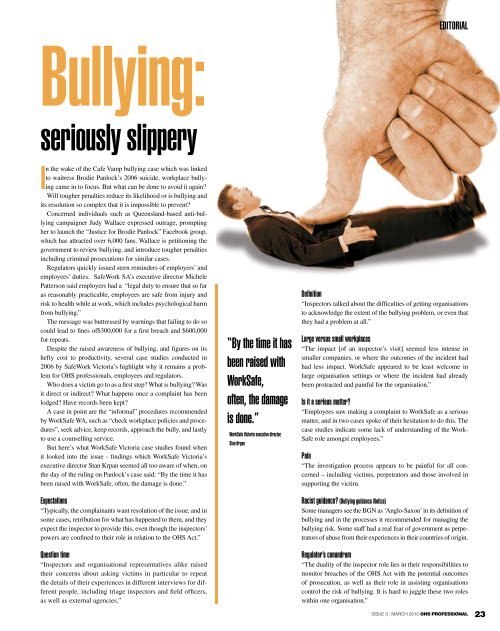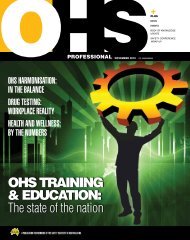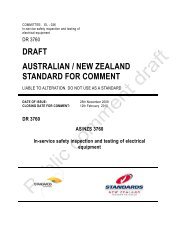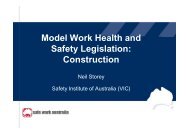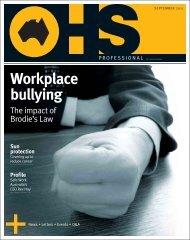Defence: overcoming its âcan Doâ culture unsW kills safety anD risk ...
Defence: overcoming its âcan Doâ culture unsW kills safety anD risk ...
Defence: overcoming its âcan Doâ culture unsW kills safety anD risk ...
You also want an ePaper? Increase the reach of your titles
YUMPU automatically turns print PDFs into web optimized ePapers that Google loves.
ullying:seriously slipperyeDitorialin the wake of the Cafe Vamp bullying case which was linkedto waitress Brodie Panlock’s 2006 suicide, workplace bullyingcame in to focus. But what can be done to avoid it again?Will tougher penalties reduce <strong>its</strong> likelihood or is bullying and<strong>its</strong> resolution so complex that it is impossible to prevent?Concerned individuals such as Queensland-based anti-bullyingcampaigner Judy Wallace expressed outrage, promptingher to launch the “Justice for Brodie Panlock” Facebook group,which has attracted over 6,000 fans. Wallace is petitioning thegovernment to review bullying, and introduce tougher penaltiesincluding criminal prosecutions for similar cases.Regulators quickly issued stern reminders of employers’ andemployees’ duties. SafeWork SA’s executive director MichelePatterson said employers had a “legal duty to ensure that so faras reasonably practicable, employees are safe from injury and<strong>risk</strong> to health while at work, which includes psychological harmfrom bullying.”The message was buttressed by warnings that failing to do socould lead to fines of$300,000 for a first breach and $600,000for repeats.Despite the raised awareness of bullying, and figures on <strong>its</strong>hefty cost to productivity, several case studies conducted in2006 by SafeWork Victoria’s highlight why it remains a problemfor OHS professionals, employees and regulators.Who does a victim go to as a first step? What is bullying? Wasit direct or indirect? What happens once a complaint has beenlodged? Have records been kept?A case in point are the “informal” procedures recommendedby WorkSafe WA, such as “check workplace policies and procedures”,seek advice, keep records, approach the bully, and lastlyto use a counselling service.But here’s what WorkSafe Victoria case studies found whenit looked into the issue - findings which WorkSafe Victoria’sexecutive director Stan Krpan seemed all too aware of when, onthe day of the ruling on Panlock’s case said: “By the time it hasbeen raised with WorkSafe, often, the damage is done.”expectations“Typically, the complainants want resolution of the issue, and insome cases, retribution for what has happened to them, and theyexpect the inspector to provide this, even though the inspectors’powers are confined to their role in relation to the OHS Act.”Question time“Inspectors and organisational representatives alike raisedtheir concerns about asking victims in particular to repeatthe details of their experiences in different interviews for differentpeople, including triage inspectors and field officers,as well as external agencies.”“by the time it hasbeen raised withWorksafe,often, the damageis done.”Worksafe victoria executive director,stan krp<strong>anD</strong>efinition“Inspectors talked about the difficulties of getting organisationsto acknowledge the extent of the bullying problem, or even thatthey had a problem at all.”large versus small workplaces“The impact [of an inspector’s visit] seemed less intense insmaller companies, or where the outcomes of the incident hadhad less impact. WorkSafe appeared to be least welcome inlarge organisation settings or where the incident had alreadybeen protracted and painful for the organisation.”is it a serious matter?“Employees saw making a complaint to WorkSafe as a seriousmatter, and in two cases spoke of their hesitation to do this. Thecase studies indicate some lack of understanding of the Work-Safe role amongst employees.”pain“The investigation process appears to be painful for all concerned– including victims, perpetrators and those involved insupporting the victim.racist guidance? (bullying guidance notice)Some managers see the BGN as ‘Anglo-Saxon’ in <strong>its</strong> definition ofbullying and in the processes it recommended for managing thebullying <strong>risk</strong>. Some staff had a real fear of government as perpetratorsof abuse from their experiences in their countries of origin.regulator’s conundrum“The duality of the inspector role lies in their responsibilities tomonitor breaches of the OHS Act with the potential outcomesof prosecution, as well as their role in assisting organisationscontrol the <strong>risk</strong> of bullying. It is hard to juggle these two roleswithin one organisation.”ISSUE 3 | MARCH 2010 OHS PrOfeSSiOnaL 23


